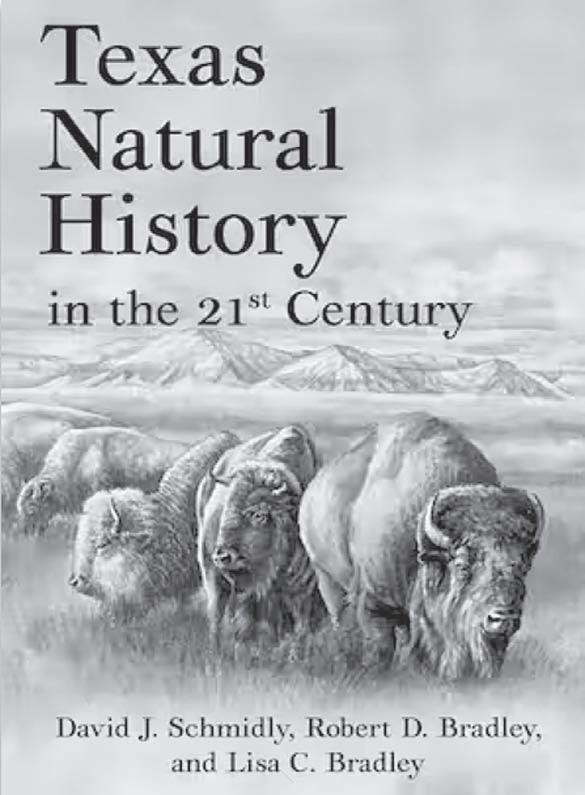
4 minute read
Daylight Saving Time ends – Nov
Page 6 • October 2022 • Golden Gazette ‘Texas Natural History in the 21st Century’ book released
“Texas Natural History in the 21st Century” is a May 2022 release from Texas Tech University Press.
Authors are David J. Schmidly, Robert D. Bradley, and Lisa C. Bradley.
Schmidly previously served as president of Texas Tech. Robert Bradley is a Texas Tech professor of biological sciences. Lisa Bradley is a research associate at the Texas Tech museum.
The book is 744 pages, 7” x 10”, hardcover and sells for $45.
Call 800-848-6224 or visit ttupress.org for online ordering.
The following is from ttupress.org:
One hundred fifty years ago, Texas was different. A
Weird is a side effect of awesome.
rural population was spread thinly across the eastern and central parts of the state, and vast lands in the western regions were still undisturbed.
Texas’s habitats and biota changed dramatically as its population increased and people spread across the landscape.
In “Texas Natural History: A Century of Change” (2002), David Schmidly chronicled the changes that occurred during the 20th century.
In this second edition, Schmidly is joined by colleagues Robert and Lisa Bradley of Texas Tech University to extend that story over the first two decades of the 21th century.
The focus of “Texas Natural History in the 21st Century” continues to be on the mammalian fauna of the state, and it includes a reprinting of Vernon Bailey’s 1905 “The Biological Survey of Texas” with new annotations and updates.
In the rest of the book, the authors discuss changes in landscapes, land use, and the status of Texas mammals in the last 100 years.
The authors present current challenges to conserving the natural history of Texas and suggest long-term solutions to those challenges, including actions focused on both private and public lands.
As Texas approaches the daunting challenge of conserving its wildlife, “Texas Natural History in the 21st Century” serves as a rallying cry for addressing the scenarios imperiling Texas’s natural history in our present day and in the future.

A Big Hair ‘Do’ eventually inspired others
“Hair” was a pop-culture phenomenon that rocked and shocked more than 30 million theatergoers during the late 1960s. So, what was all the fuss about? Well, actually, a number of things.
“Hair” rejected every Broadway convention when onstage hippies promoted peace, love and understanding, as well as plentiful doses of sex, drugs and rock ‘n’ roll.
And—briefly—naked flesh.
The “Hair” history began in 1964 when two off-Broadway actor pals—James Rado and Gerome Ragni—decided to create a rock musical about Manhattan’s East Village longhairs.
Dubbed The Tribe, these young counter-culturists spent their days hanging out, getting high and avoiding the draft. (At the time, hippies nationwide were protesting the Vietnam war, racism, and sexual politics.)
Rado once described the inspiration for his would-be participants as “a combination of some characters we met in the streets, people we knew, and our own imaginations. There was so much excitement in the streets and the parks and the hippie areas, and we thought if we could transmit this excitement to the stage, it would be wonderful.”
While James and Gerome focused on dialogue, they assigned songwriting chores to a straight-laced, non-counterculture Canadian named Galt MacDermot, who explained years later, “I’d never even heard of a hippie when I met Rado and Ragni.” McDermot did, however, share their enthusiasm about creating a
radical rock ‘n’ roll drama.
The show’s title was inspired by a museum stroll that Rado and Ragni took one afternoon, when they spied a painting of a tuft of hair (not surprisingly labeled “Hair”) by pop artist Jim Dine, who had been associated with numerous art movements over the years.
In 1967, the first production of “Hair” opened 40 blocks away from the Great White Way in an East Village off-Broadway venue called the Public. The presentation featured 20 songs and fully clothed performers. Broadway investors had soberly turned thumbs down on the controversial offering; “Hair,” however, quickly became the hot ticket for hip, younger Big Apple theatergoers.
On April 29, 1968—six months after making its debut—a revised “Hair” opened at Broadway’s Biltmore Theater and included some major changes. Thirteen additional songs had been added. The stage cast had become multi-ethnic. And, because a city ordinance allowed nudity if the actors remained motionless, the end of Act One featured a dimly lit tableau of the unclothed.
Four years later, Broadway’s first rock musical closed after a record-breaking 1,750 performances. When the original stage cast recording sold 3 million albums, New York Times critic Charles Isherwood advised, “For an escapist dose of the sweet sound of youth brimming with hope that the world is going to change tomorrow, listen to “Hair” and let the sunshine in.”
During its remarkable run, Hair had generated millionselling singles for the Fifth Dimension (“Aquarius/Let the Sunshine In’), the Cowsills (“Hair”), Three Dog Night (“Easy to Be Hard”), and Oliver (“Good Morning Starshine”).
A dazzling light at the dawning of the Age of Aquarius, “Hair” would eventually inspire “Jesus Christ Superstar,” “Grease” and “Dreamgirls.”





